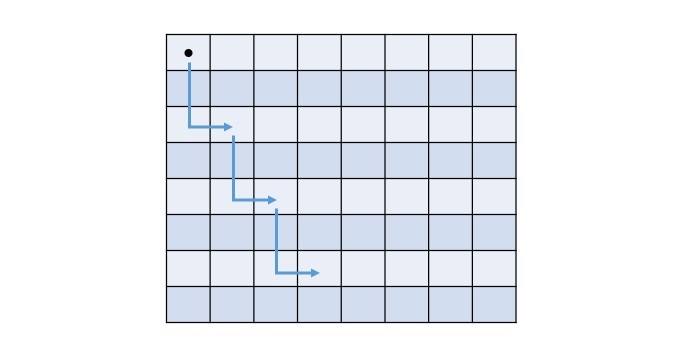
- 数据结构与算法
- DSA - 首页
- DSA - 概述
- DSA - 环境搭建
- DSA - 算法基础
- DSA - 渐进分析
- 数据结构
- DSA - 数据结构基础
- DSA - 数据结构和类型
- DSA - 数组数据结构
- 链表
- DSA - 链表数据结构
- DSA - 双向链表数据结构
- DSA - 循环链表数据结构
- 栈与队列
- DSA - 栈数据结构
- DSA - 表达式解析
- DSA - 队列数据结构
- 搜索算法
- DSA - 搜索算法
- DSA - 线性搜索算法
- DSA - 二分搜索算法
- DSA - 插值搜索
- DSA - 跳跃搜索算法
- DSA - 指数搜索
- DSA - 斐波那契搜索
- DSA - 子列表搜索
- DSA - 哈希表
- 排序算法
- DSA - 排序算法
- DSA - 冒泡排序算法
- DSA - 插入排序算法
- DSA - 选择排序算法
- DSA - 归并排序算法
- DSA - 希尔排序算法
- DSA - 堆排序
- DSA - 桶排序算法
- DSA - 计数排序算法
- DSA - 基数排序算法
- DSA - 快速排序算法
- 图数据结构
- DSA - 图数据结构
- DSA - 深度优先遍历
- DSA - 广度优先遍历
- DSA - 生成树
- 树数据结构
- DSA - 树数据结构
- DSA - 树的遍历
- DSA - 二叉搜索树
- DSA - AVL树
- DSA - 红黑树
- DSA - B树
- DSA - B+树
- DSA - 伸展树
- DSA - 字典树
- DSA - 堆数据结构
- 递归
- DSA - 递归算法
- DSA - 使用递归实现汉诺塔问题
- DSA - 使用递归实现斐波那契数列
- 分治法
- DSA - 分治法
- DSA - 最大最小问题
- DSA - Strassen矩阵乘法
- DSA - Karatsuba算法
- 贪心算法
- DSA - 贪心算法
- DSA - 旅行商问题(贪心算法)
- DSA - Prim最小生成树算法
- DSA - Kruskal最小生成树算法
- DSA - Dijkstra最短路径算法
- DSA - 地图着色算法
- DSA - 分数背包问题
- DSA - 带截止日期的作业排序
- DSA - 最优合并模式算法
- 动态规划
- DSA - 动态规划
- DSA - 矩阵链乘法
- DSA - Floyd-Warshall算法
- DSA - 0-1背包问题
- DSA - 最长公共子序列算法
- DSA - 旅行商问题(动态规划)
- 近似算法
- DSA - 近似算法
- DSA - 顶点覆盖算法
- DSA - 集合覆盖问题
- DSA - 旅行商问题(近似算法)
- 随机化算法
- DSA - 随机化算法
- DSA - 随机化快速排序算法
- DSA - Karger最小割算法
- DSA - Fisher-Yates洗牌算法
- DSA有用资源
- DSA - 问答
- DSA - 快速指南
- DSA - 有用资源
- DSA - 讨论
骑士巡游问题
什么是骑士巡游问题?
在骑士巡游问题中,我们得到一个大小为NxN的空棋盘和一个骑士。在国际象棋中,骑士是一个看起来像马的棋子。假设它可以从棋盘上的任何位置开始。现在,我们的任务是检查骑士是否可以访问棋盘上的所有方格。当它可以访问所有方格时,打印从起始位置到达该位置所需的跳跃次数。
骑士可以有两种方式完成它的巡游。在第一种方式中,骑士移动一步并返回到起始位置形成一个循环,这称为闭合巡游。在第二种方式即开放巡游中,它在棋盘上的任何位置结束。
对于不熟悉国际象棋的人,请注意骑士的移动方式很特殊。它可以在每个方向上水平移动两个方格和垂直移动一个方格,或者垂直移动两个方格和水平移动一个方格。因此,完整的移动看起来像英文字母'L'。

假设给定棋盘的大小为8,并且骑士位于棋盘的左上角位置。接下来的可能的移动如下所示:

上面棋盘中的每个单元格都包含一个数字,表示从哪里开始以及骑士需要多少步才能到达一个单元格。单元格的最终值将由以下矩阵表示:
0 59 38 33 30 17 8 63 37 34 31 60 9 62 29 16 58 1 36 39 32 27 18 7 35 48 41 26 61 10 15 28 42 57 2 49 40 23 6 19 47 50 45 54 25 20 11 14 56 43 52 3 22 13 24 5 51 46 55 44 53 4 21 12
请记住,此问题可能有多个解决方案,上面的矩阵是一个可能的解决方案。
解决骑士巡游问题的一种方法是逐一生成所有巡游,然后检查它们是否满足指定的约束条件。但是,这很耗时,不是一种有效的方法。
回溯法解决骑士巡游问题
解决此问题的另一种方法是使用回溯法。这是一种尝试不同可能性直到找到解决方案或尝试所有选项的技术。它包括选择一个移动,执行它,然后递归地尝试解决问题的其余部分。如果当前移动导致死胡同,我们回溯并撤消该移动,然后尝试另一个移动。
要使用回溯法解决骑士巡游问题,请按照以下步骤操作:
从棋盘上的任何一个单元格开始,并将其标记为骑士已访问。
将骑士移动到一个有效的未访问单元格,并将其标记为已访问。从任何一个单元格,骑士最多可以进行8次移动。
如果当前单元格无效或没有通往解决方案的路径,则回溯并尝试其他可能通往解决方案的移动。
重复此过程,直到骑士的移动次数等于8 x 8 = 64。
示例
在下面的示例中,我们将实际演示如何解决骑士巡游问题。
#include <stdio.h>
#define N 8
int sol[N][N];
//check place is in range and not assigned yet
int isValid(int x, int y) {
return ( x >= 0 && x < N && y >= 0 && y < N && sol[x][y] == -1);
}
void displaySolution() {
printf("The possible solution: \n");
for (int x = 0; x < N; x++) {
for (int y = 0; y < N; y++)
printf("%3d ", sol[x][y]);
printf("\n");
}
}
int knightTour(int x, int y, int move, int xMove[N], int yMove[N]) {
int xNext, yNext;
//when the total board is covered
if (move == N*N)
return 1;
for (int k = 0; k < 8; k++) {
xNext = x + xMove[k];
yNext = y + yMove[k];
//check room is preoccupied or not
if (isValid(xNext, yNext)) {
sol[xNext][yNext] = move;
if (knightTour(xNext, yNext, move+1, xMove, yMove) == 1)
return 1;
else
// backtracking
sol[xNext][yNext] = -1;
}
}
return 0;
}
int findKnightTourSol() {
//initially set all values to -1 of solution matrix
for (int x = 0; x < N; x++)
for (int y = 0; y < N; y++)
sol[x][y] = -1;
//all possible moves for knight
int xMove[8] = { 2, 1, -1, -2, -2, -1, 1, 2 };
int yMove[8] = { 1, 2, 2, 1, -1, -2, -2, -1 };
//starting from room (0, 0)
sol[0][0] = 0;
if (knightTour(0, 0, 1, xMove, yMove) == 0) {
printf("Solution does not exist");
return 0;
} else
displaySolution();
return 1;
}
int main() {
findKnightTourSol();
return 0;
}
#include <iostream>
#include <iomanip>
#define N 8
using namespace std;
int sol[N][N];
//check place is in range and not assigned yet
bool isValid(int x, int y, int sol[N][N]) {
return ( x >= 0 && x < N && y >= 0 && y < N && sol[x][y] == -1);
}
void displaySolution() {
cout << "The possible solution: " << endl;
for (int x = 0; x < N; x++) {
for (int y = 0; y < N; y++)
cout << setw(3) << sol[x][y] << " ";
cout << endl;
}
}
int knightTour(int x, int y, int move, int sol[N][N], int xMove[N], int yMove[N]) {
int xNext, yNext;
//when the total board is covered
if (move == N*N)
return true;
for (int k = 0; k < 8; k++) {
xNext = x + xMove[k];
yNext = y + yMove[k];
//check room is preoccupied or not
if (isValid(xNext, yNext, sol)) {
sol[xNext][yNext] = move;
if (knightTour(xNext, yNext, move+1, sol, xMove, yMove) == true)
return true;
else
// backtracking
sol[xNext][yNext] = -1;
}
}
return false;
}
bool findKnightTourSol() {
//initially set all values to -1 of solution matrix
for (int x = 0; x < N; x++)
for (int y = 0; y < N; y++)
sol[x][y] = -1;
//all possible moves for knight
int xMove[8] = { 2, 1, -1, -2, -2, -1, 1, 2 };
int yMove[8] = { 1, 2, 2, 1, -1, -2, -2, -1 };
//starting from room (0, 0)
sol[0][0] = 0;
if (knightTour(0, 0, 1, sol, xMove, yMove) == false) {
cout << "Solution does not exist";
return false;
} else
displaySolution();
return true;
}
int main() {
findKnightTourSol();
}
import java.util.Arrays;
public class Main {
static final int N = 8;
static int[][] sol = new int[N][N];
//check place is in range and not assigned yet
static boolean isValid(int x, int y) {
return (x >= 0 && x < N && y >= 0 && y < N && sol[x][y] == -1);
}
static void displaySolution() {
System.out.println("The possible solution: ");
for (int x = 0; x < N; x++) {
for (int y = 0; y < N; y++)
System.out.printf("%3d ", sol[x][y]);
System.out.println();
}
}
static boolean knightTour(int x, int y, int move, int[] xMove, int[] yMove) {
int xNext, yNext;
//when the total board is covered
if (move == N*N)
return true;
for (int k = 0; k < 8; k++) {
xNext = x + xMove[k];
yNext = y + yMove[k];
//check room is preoccupied or not
if (isValid(xNext, yNext)) {
sol[xNext][yNext] = move;
if (knightTour(xNext, yNext, move+1, xMove, yMove))
return true;
else
// backtracking
sol[xNext][yNext] = -1;
}
}
return false;
}
static boolean findKnightTourSol() {
//initially set all values to -1 of solution matrix
for (int[] row : sol)
Arrays.fill(row, -1);
//all possible moves for knight
int[] xMove = {2, 1, -1, -2, -2, -1, 1, 2};
int[] yMove = {1, 2, 2, 1, -1, -2, -2, -1};
//starting from room (0, 0)
sol[0][0] = 0;
if (!knightTour(0, 0, 1, xMove, yMove)) {
System.out.println("Solution does not exist");
return false;
} else
displaySolution();
return true;
}
public static void main(String[] args) {
findKnightTourSol();
}
}
N = 8
# The solution matrix
sol = [[-1 for _ in range(N)] for _ in range(N)]
# Check if place is in range and not assigned yet
def isValid(x, y):
return (x >= 0 and x < N and y >= 0 and y < N and sol[x][y] == -1)
# Function to print the solution
def displaySolution():
print("The possible solution: ")
for x in range(N):
for y in range(N):
print(f"{sol[x][y]:3}", end=" ")
print()
# Recursive function to solve the problem
def knightTour(x, y, move, xMove, yMove):
if move == N*N:
return True
for k in range(8):
xNext = x + xMove[k]
yNext = y + yMove[k]
if isValid(xNext, yNext):
sol[xNext][yNext] = move
if knightTour(xNext, yNext, move+1, xMove, yMove):
return True
else:
# Backtracking
sol[xNext][yNext] = -1
return False
def findKnightTourSol():
# All possible moves for knight
xMove = [2, 1, -1, -2, -2, -1, 1, 2]
yMove = [1, 2, 2, 1, -1, -2, -2, -1]
# Starting from room (0, 0)
sol[0][0] = 0
if not knightTour(0, 0, 1, xMove, yMove):
print("Solution does not exist")
return False
else:
displaySolution()
return True
if __name__ == "__main__":
findKnightTourSol()
输出
The possible solution: 0 59 38 33 30 17 8 63 37 34 31 60 9 62 29 16 58 1 36 39 32 27 18 7 35 48 41 26 61 10 15 28 42 57 2 49 40 23 6 19 47 50 45 54 25 20 11 14 56 43 52 3 22 13 24 5 51 46 55 44 53 4 21 12